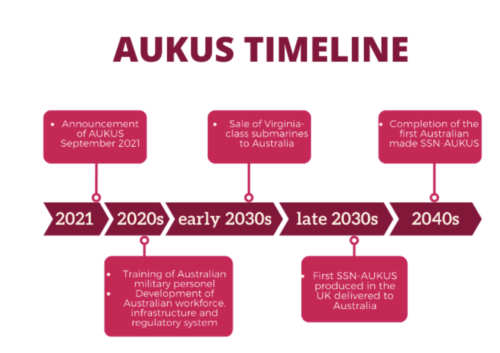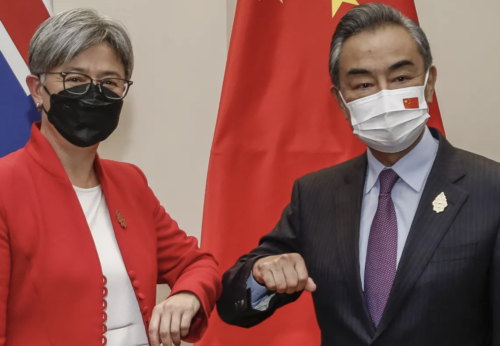

AUKUS, a trilateral security partnership between Australia, the UK and the United States, launched in September 2021 with the intention of creating a “free and stable Indo-Pacific,” returned to the political limelight earlier this month as specific details of the undertaking became clearer. Whilst the national security rationale for the partnership – exemplified by what senior US officials call Chinese “provocations in the South China sea and around Taiwan”- remains unchanged, it is the potential economic impact of the projected defence spending that has renewed fierce debate.
AUKUS’ first major initiative is Australia’s procurement of conventionally armed, nuclear-powered submarines (SSNs), resulting in the controversial abandonment of the planned construction of 12 French Attack-class diesel submarines. Estimated to cost between $268-368 billion across the next 30 years, the process involves the development of the Australian workforce, infrastructure and navy with American and British support. As per the current timeline, the purchase of Virginia-class submarines from the US and the delivery of the first SSN-AUKUS submarine will occur in the 2030s, with the first Australian made nuclear submarine completed by the 2040s.

These proposed investments are projected to result in significant economic benefits for Australian industry and infrastructure. South Australia is at centre stage, where a planned submarine construction yard in Osborne will produce parts for UK and US production lines, and later Australian submarines. Western Australia also stands to gain with the expansion of the HMAS Stirling naval base to accommodate visiting nuclear submarines, and later Australia’s own SSN-AUKUS.
Overall, the project is forecasted to create 20,000 jobs across the next 30 years in Australia, with 8,500 of these directly involved in servicing and building the submarines. The projected job opportunities will span across nuclear science, engineering, manufacturing, the public service, defence and more. For Australia, AUKUS presents a unique opportunity to strengthen local human capital in STEM, easing its dependence on immigration to address skill gaps in a STEM-deficient workforce – a non-trivial outcome in matters of national security.
Furthermore, the Australian Department of Defence claims that this boost to the technical capabilities of the workforce will have flow-on effects on related industries; innovation in defence often has wider applications outside of the military, expanding the breadth of capital and consumer goods and boosting national productivity. In fact, many inventions used in civilian life, ranging from satellite navigation and radar technology to duct tape and sanitary napkins, all find their origin in defence engineering.
Although the projected gains for Australian jobs and industry are significant, unions remain divided. President of the Australian Council of Trade Unions Michelle O’Neil contends that these nuclear submarine plans contradict a long-standing union position against nuclear power, nuclear defence policy, and proliferation. Nonetheless, O’Neil denied preferring conventional submarines, stating, “this is something we will be bringing our affiliates to discuss”. Similarly, the Australian Shipbuilding Federation of Unions released a report expressing concern over a ‘submarine capability gap’, especially considering Australia’s current fleet is set to retire around the time the nation’s first SSN-AUKUS is built in the 2040s. They recommended building six new Collins class diesel-electric submarines in the meantime to bridge this gap.
On the international stage, members of AUKUS remain committed to non-proliferation of nuclear weapons; indeed, the nuclear fuel Australia will receive under this project is not fit for use in nuclear weapons without further chemical processing that Australia is unable to do and will not seek to do. However, Beijing is not convinced, with the Chinese Mission to the UN stating that the move “undermines international non-proliferation system, fuels arms races, and hurts peace and stability in the region” in an effort to diplomatically impede these plans.
The reaction in the Chinese foreign policy circles is indicative of the tremendous strain AUKUS has and will continue to place on Australia’s relationship with China, the destination for nearly a third of all Australian exports. Hence, an economic analysis of AUKUS must extend beyond the initial defence spend and the corresponding multiplier and examine its multifaceted impacts in the domain of trade.
China is Australia’s largest two way trading partner, with a trade relationship largely driven by the growth of the Chinese economy coupled with the 2015 China-Australia Free Trade Agreement. Although slowing economic growth in the wake of the COVID pandemic, as well as tariffs (such as those on barley) imposed in the backdrop of escalating tensions, have weakened this trade relationship, it remains a partnership that is crucial to the Australian economy.

With China perceiving the AUKUS submarine deal as a threat to its geopolitical security interests, the potential for trade related reprisals looms large. Such economic retaliation – which China has been willing to take before – would be devastating due to China’s size and centrality to the global economy. However, there is also a possibility that anti-AUKUS rhetoric could remain just that, with Chinese and Australian officials making significant diplomatic strides in recent months. Practically, this looks like sideline discussions between leaders at the G20 in Bali last year, meetings between trade ministers, as well as Foreign Minister Penny Wong’s visit to China late last year.
However, in the event of harsh repercussions from China, this deal may provide further impetus for Australia to explore its long term trade options to diversify its economy, particularly looking towards India and Indonesia. Such potential partners, poised to grow their economic power over the short to medium term provide useful alternatives for Australia, particularly due to their relative geographic proximity and structure of their economy.
Irrespective of China’s reaction, the deal indicates Australia’s commitment to a post-WWII order largely shaped by the West, an order that has notably benefitted Australia. Such a sizeable deal will further increase goodwill and economic integration between AUKUS countries, further benefiting Australia’s ability to lean into these old alliances as a trade alternative to China.
However, expanding the breadth of trade partners may not be the only diversification opportunity for Australia stemming from the AUKUS deal. The investment in nuclear submarines opens the door for a recalibration of Australia’s domestic economic resources towards a potential civilian nuclear industry, bringing forth arguments old and new.
With the AUKUS deal now forming the foundation of Australia’s national security, the country is faced with a formidable “task of human capability acquisition” – in other words, mustering a workforce large and capable enough to build, operate and maintain the nuclear reactors. Therefore, many pundits now suggest that the establishment of a civilian nuclear industry will augment this keystone of Australia’s defence by stimulating a specialised workforce. It is logical that increased job opportunities, and by extension improved job security, in nuclear science and engineering, will lead to more individuals undertaking the education and training required by that profession. Moreover, the classic argument of high entry costs to nuclear power generation is negated by the fact that we are, whether we like it or not, undertaking it, at least in a military fashion.
However, while bringing forth a swathe of new arguments for investing in Australian nuclear energy, AUKUS has also exacerbated the old. Fears of nuclear weaponisation in the region are especially heightened; for many, the step from nuclear powered submarines to nuclear armed submarines is a disconcertingly small one. Furthermore, nuclear, since 1945, has been seen as supremely escalatory in all its military forms. Thus, for those who desperately want to avoid war with China, the strategy of increasing Western nuclear presence in the Pacific is a grave mistake that could instigate conflict. In other words, whilst civilian nuclear itself is not threatening, its opponents contend that due to its potential to assist AUKUS, it will ultimately influence the geopolitics of the Pacific region.
This debate on Australian civilian nuclear power is not new, and has remained fairly constant. Indeed, the AUKUS deal brings the nation no closer to a consensus on the matter, instead introducing new factors to be considered by both sides. Interestingly, neither side objects to the argument that a sophisticated civilian nuclear industry will enhance military capability. Instead, they disagree on whether such an enhanced military is in the interest of the nation, and humanity as a whole. Fundamentally, AUKUS has forced pundits to view commercial nuclear through a military lens, as it is abundantly clear that Australian nuclear will never remain purely civilian.
In conclusion, AUKUS’ economic impact is multifaceted and extends beyond defence spending, as it could significantly influence Australia’s trade relations with China, which is its largest trading partner. Nevertheless, the projected economic gains in terms of job creation, innovation, and technological capacity for the Australian workforce are significant, with AUKUS providing an opportunity to strengthen local human capital in STEM. This trilateral partnership remains committed to non-proliferation of nuclear weapons, but Beijing has expressed concerns about its effects on regional peace and stability. Therefore, AUKUS’ impact on trade and security relations in the Indo-Pacific region is an open question that can only be answered with time.
Images sourced from: Guardian, Insider.com
The CAINZ Digest is published by CAINZ, a student society affiliated with the Faculty of Business at the University of Melbourne. Opinions published are not necessarily those of the publishers, printers or editors. CAINZ and the University of Melbourne do not accept any responsibility for the accuracy of information contained in the publication.